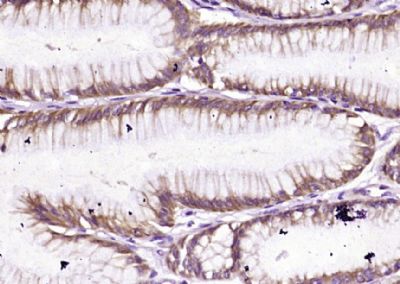TCHP Polyclonal Antibody
Purified Rabbit Polyclonal Antibody (Pab)
- SPECIFICATION
- CITATIONS
- PROTOCOLS
- BACKGROUND

Application
| IHC-P, IHC-F, IF, E |
|---|---|
| Primary Accession | Q9BT92 |
| Reactivity | Rat, Pig, Dog, Bovine |
| Host | Rabbit |
| Clonality | Polyclonal |
| Calculated MW | 55 KDa |
| Physical State | Liquid |
| Immunogen | KLH conjugated synthetic peptide derived from human TCHP |
| Epitope Specificity | 401-498/498 |
| Isotype | IgG |
| Purity | affinity purified by Protein A |
| Buffer | 0.01M TBS (pH7.4) with 1% BSA, 0.02% Proclin300 and 50% Glycerol. |
| SUBCELLULAR LOCATION | Cytoplasm, cytoskeleton. Cytoplasm. Cell membrane. Mitochondrion. |
| SIMILARITY | Belongs to the TCHP family. |
| SUBUNIT | Interacts specifically with keratin proteins including, KRT5, KRT6A, KRT8, KRT14, KRT16 and KRT18. |
| Important Note | This product as supplied is intended for research use only, not for use in human, therapeutic or diagnostic applications. |
| Background Descriptions | A tumour suppressor protein which may act as a 'capping' or 'branching' protein for keratin filaments in the cell periphery. |
| Gene ID | 84260 |
|---|---|
| Other Names | Trichoplein keratin filament-binding protein, Protein TCHP, Mitochondrial protein with oncostatic activity, Mitostatin, Tumor suppressor protein, TCHP {ECO:0000312|EMBL:AAH04285.1} |
| Target/Specificity | Expressed at high levels in normal urothelial and breast epithelial cells. Also expressed in the smooth muscle and endothelial cells. Reduced expression seen in advanced bladder and breast carcinomas (at protein level). Ubiquitous. Expressed at highest levels in the heart, skeletal muscle, kidney, liver and testis. |
| Dilution | IHC-P=1:100-500,IHC-F=1:100-500,IF=1:100-500,ELISA=1:5000-10000 |
| Storage | Store at -20 ℃ for one year. Avoid repeated freeze/thaw cycles. When reconstituted in sterile pH 7.4 0.01M PBS or diluent of antibody the antibody is stable for at least two weeks at 2-4 ℃. |
| Name | TCHP {ECO:0000312|EMBL:AAH04285.1} |
|---|---|
| Function | Tumor suppressor which has the ability to inhibit cell growth and be pro-apoptotic during cell stress. Inhibits cell growth in bladder and prostate cancer cells by a down-regulation of HSPB1 by inhibiting its phosphorylation. May act as a 'capping' or 'branching' protein for keratin filaments in the cell periphery. May regulate K8/K18 filament and desmosome organization mainly at the apical or peripheral regions of simple epithelial cells (PubMed:15731013, PubMed:18931701). Is a negative regulator of ciliogenesis (PubMed:25270598). |
| Cellular Location | Cytoplasm, cytoskeleton. Cytoplasm Cell membrane. Mitochondrion. Cell junction, desmosome. Cytoplasm, cytoskeleton, microtubule organizing center, centrosome |
| Tissue Location | Expressed at high levels in normal urothelial and breast epithelial cells. Also expressed in the smooth muscle and endothelial cells. Reduced expression seen in advanced bladder and breast carcinomas (at protein level). Ubiquitous. Expressed at highest levels in the heart, skeletal muscle, kidney, liver and testis |

Thousands of laboratories across the world have published research that depended on the performance of antibodies from Abcepta to advance their research. Check out links to articles that cite our products in major peer-reviewed journals, organized by research category.
info@abcepta.com, and receive a free "I Love Antibodies" mug.
Provided below are standard protocols that you may find useful for product applications.
If you have used an Abcepta product and would like to share how it has performed, please click on the "Submit Review" button and provide the requested information. Our staff will examine and post your review and contact you if needed.
If you have any additional inquiries please email technical services at tech@abcepta.com.













 Foundational characteristics of cancer include proliferation, angiogenesis, migration, evasion of apoptosis, and cellular immortality. Find key markers for these cellular processes and antibodies to detect them.
Foundational characteristics of cancer include proliferation, angiogenesis, migration, evasion of apoptosis, and cellular immortality. Find key markers for these cellular processes and antibodies to detect them. The SUMOplot™ Analysis Program predicts and scores sumoylation sites in your protein. SUMOylation is a post-translational modification involved in various cellular processes, such as nuclear-cytosolic transport, transcriptional regulation, apoptosis, protein stability, response to stress, and progression through the cell cycle.
The SUMOplot™ Analysis Program predicts and scores sumoylation sites in your protein. SUMOylation is a post-translational modification involved in various cellular processes, such as nuclear-cytosolic transport, transcriptional regulation, apoptosis, protein stability, response to stress, and progression through the cell cycle. The Autophagy Receptor Motif Plotter predicts and scores autophagy receptor binding sites in your protein. Identifying proteins connected to this pathway is critical to understanding the role of autophagy in physiological as well as pathological processes such as development, differentiation, neurodegenerative diseases, stress, infection, and cancer.
The Autophagy Receptor Motif Plotter predicts and scores autophagy receptor binding sites in your protein. Identifying proteins connected to this pathway is critical to understanding the role of autophagy in physiological as well as pathological processes such as development, differentiation, neurodegenerative diseases, stress, infection, and cancer.


